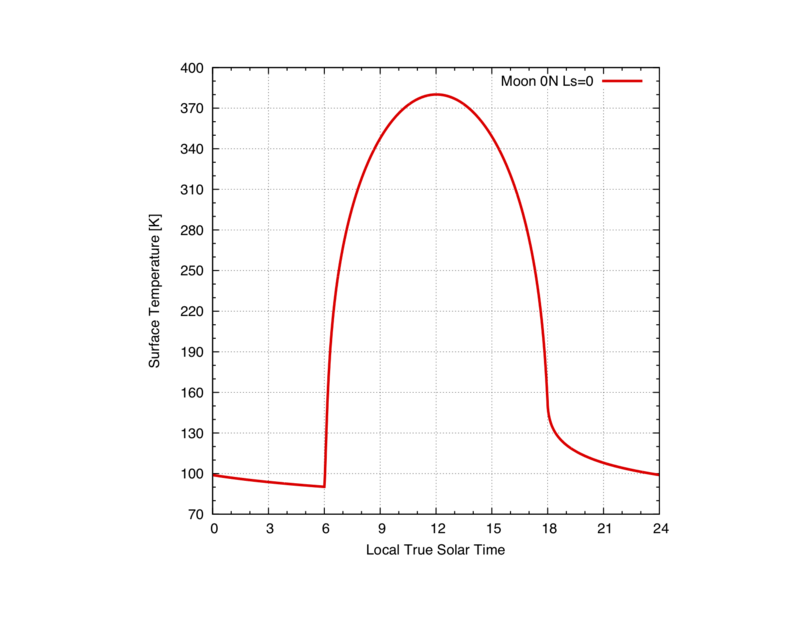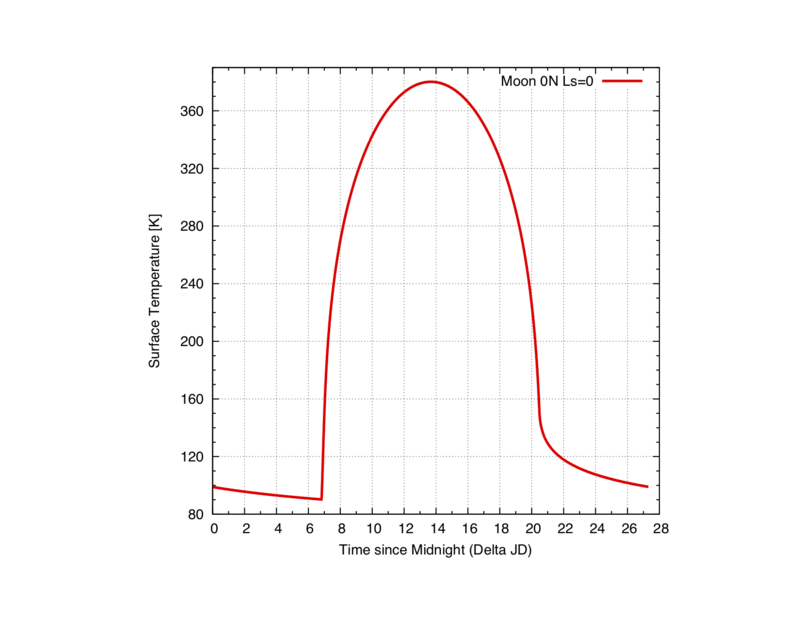KRC for The Moon
(Created page with "Set body = "Earth,Moon", and bodytype = "minor" to culacate temperatures on the Moon: out = krc(lat = 0, INERTIA = 45., body="Earth,Moon", bodytype = "minor", ALBEDO = .12, ...") |
|||
| (8 intermediate revisions by one user not shown) | |||
| Line 1: | Line 1: | ||
| − | Set body = " | + | Set body = "Moon" to calculate temperatures on the Moon: |
| − | out = krc(lat = 0, INERTIA = 45., body=" | + | out = krc(lat=0,INERTIA=45.,body="Moon",ALBEDO=.12,LKofT="F",ls=0.) |
| − | [[Image:Moon_1.png| | + | [[Image:Moon_1.png|800px]] |
| − | + | Note: KRC for the Moon has not been formally validated. | |
| − | + | By default, the temperature dependence of the thermal conductivity uses a Moon-like trend (k_style = "Moon"). | |
| − | + | For bodies where the duration of a day is significantly longer than the duration of an Earth day like the Moon, the local true solar time can be displayed both as a fraction of 24 (out.time, see above example)... | |
| + | |||
| + | ...or as a delta Julian Date since the local midnight (out.deltaJD): | ||
| + | |||
| + | plot(out.tsurf[,1,1],xaxis=out.deltaJD[,1,1]) | ||
| + | |||
| + | [[Image:Moon_3.png|800px]] | ||
| + | |||
| + | == Defining a Date == | ||
| + | |||
| + | Seasons can be defined as Ls (ls), Julian Date (JD), and Gregorian Date (GD): | ||
| + | |||
| + | OUT = krc(body="Moon",lat=25.,ls=90.) | ||
| + | |||
| + | For a specific Gregorian Date, GD (currently ranging from 1990-Jan-01 to 2040-Jan-01), the format is ????-Mmm-DD, | ||
| + | with Mmm:Jan, Feb, Mar, Apr, May, Jun, Jul, Aug, Sep, Oct, Nov, Dec; | ||
| + | |||
| + | OUT = krc(body="Moon",lat=12.,GD="2010-Jan-05") | ||
| + | |||
| + | or a specific Julian Date JD: | ||
| + | |||
| + | OUT = krc(body="Moon",lat=12.,JD=2455201) | ||
| + | |||
| + | Note: the possibility to specify the date with GD is only currently available for Mars, the Moon, Bennu, and Europa. | ||
Latest revision as of 15:56, 10 April 2020
Set body = "Moon" to calculate temperatures on the Moon:
out = krc(lat=0,INERTIA=45.,body="Moon",ALBEDO=.12,LKofT="F",ls=0.)
Note: KRC for the Moon has not been formally validated.
By default, the temperature dependence of the thermal conductivity uses a Moon-like trend (k_style = "Moon").
For bodies where the duration of a day is significantly longer than the duration of an Earth day like the Moon, the local true solar time can be displayed both as a fraction of 24 (out.time, see above example)...
...or as a delta Julian Date since the local midnight (out.deltaJD):
plot(out.tsurf[,1,1],xaxis=out.deltaJD[,1,1])
[edit] Defining a Date
Seasons can be defined as Ls (ls), Julian Date (JD), and Gregorian Date (GD):
OUT = krc(body="Moon",lat=25.,ls=90.)
For a specific Gregorian Date, GD (currently ranging from 1990-Jan-01 to 2040-Jan-01), the format is ????-Mmm-DD, with Mmm:Jan, Feb, Mar, Apr, May, Jun, Jul, Aug, Sep, Oct, Nov, Dec;
OUT = krc(body="Moon",lat=12.,GD="2010-Jan-05")
or a specific Julian Date JD:
OUT = krc(body="Moon",lat=12.,JD=2455201)
Note: the possibility to specify the date with GD is only currently available for Mars, the Moon, Bennu, and Europa.

